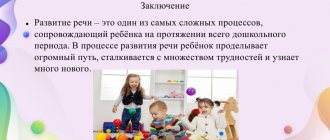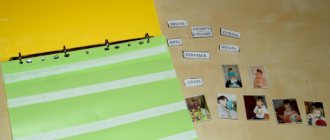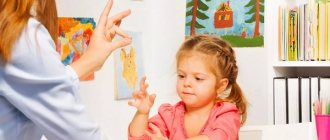Topic: “Methods and techniques for speech development”
Topic: “Methods and techniques for speech development”
The method of speech development is defined as a way of activity of the teacher and children, ensuring the formation of speech skills and abilities.
There are three groups of methods
- visual, verbal and practical. This division is very arbitrary, since there is no sharp boundary between them. Visual methods are accompanied by words, and verbal methods use visual techniques. Practical methods are also associated with both words and visual material. The classification of some methods and techniques as visual, others as verbal or practical depends on the predominance of visibility, words or actions as the source and basis of the statement.
Visual methods
are used more often in parole.
Both direct and indirect methods are used. The direct
method includes the observation method and its varieties: excursions, inspections of the premises, examination of natural objects.
These methods are aimed at accumulating the content of speech and providing communication between two signaling systems. Indirect methods
are based on the use of visual clarity. This is looking at toys, paintings, photographs, describing paintings and toys, telling stories about toys and paintings. They are used to consolidate knowledge, vocabulary, develop the generalizing function of words, and teach coherent speech. Indirect methods can also be used to get acquainted with objects and phenomena that cannot be encountered directly.
Verbal methods
in kindergarten they are used less often: this is reading and telling works of fiction, memorizing, retelling, generalizing conversation, telling without relying on visual material. All verbal methods use visual techniques: showing objects, toys, paintings, looking at illustrations, since the age characteristics of young children and the nature of the word itself require visualization.
Practical methods
aimed at using speech skills and abilities and improving them. Practical methods include various didactic games, dramatization games, dramatizations, didactic exercises, plastic sketches, and round dance games. They are used to solve all speech problems.
Depending on the nature of children’s speech activity, reproductive and productive methods can be roughly distinguished.
Reproductive methods are based on reproducing speech material and ready-made samples. In preschool education, they are used mainly in vocabulary work, in the work of educating the sound culture of speech, and less in the formation of grammatical skills and coherent speech. Reproductive methods can conditionally include methods of observation and its varieties, looking at pictures, reading fiction, retelling, memorizing, games-dramatization of the content of literary works, many didactic games, i.e. all those methods in which children master words and the laws of their combination, phraseological phrases, some grammatical phenomena, for example, the management of many words, master by imitation of sound pronunciation, retell close to the text, copy the teacher’s story.
Productive methods involve children constructing their own coherent utterances, when the child does not simply reproduce the language units known to him, but selects and combines them in a new way each time, adapting to the communication situation. This is the creative nature of speech activity. From this it is obvious that productive methods are used in teaching coherent speech. These include generalizing conversation, storytelling, retelling with text restructuring, didactic games for the development of coherent speech, modeling method, creative tasks.
There is also no sharp boundary between productive and reproductive methods. There are elements of creativity in reproductive methods, and elements of reproduction in productive methods.
Depending on the task of speech development, methods of vocabulary work, methods
of educating the sound culture of speech, etc. are distinguished.
Methodological techniques for speech development are traditionally divided into three main groups:
verbal, visual and playful.
Verbal techniques are widely used
These include speech pattern, repeated speaking, explanation, instructions, assessment of children's speech, question.
Speech sample
- correct, pre-thought-out speech activity of the teacher, intended for imitation by children and their orientation. The sample must be accessible in content and form. It is pronounced clearly, loudly and slowly. Since the model is given for imitation, it is presented before the children begin their speech activity. But sometimes, especially in older groups, a model can be used after children’s speech, but it will not serve for imitation, but for comparison and correction. The sample is used to solve all problems. It is especially important in younger groups.
Repeated recitation
- deliberate, repeated repetition of the same speech element (sound, word, phrase) for the purpose of memorizing it. In practice, different repetition options are used: behind the teacher, behind other children, joint repetition of the teacher and children, choral repetition. It is important that repetition is offered to children in the context of an activity that interests them.
Explanation
- revealing the essence of certain phenomena or methods of action. Widely used to reveal the meanings of words, to explain the rules and actions in didactic games, as well as in the process of observing and examining objects.
Directions
— explaining to children the method of action to achieve a certain result. There are instructional, organizational and disciplinary instructions.
Assessment of children's speech
— a motivated judgment about a child’s speech utterance, characterizing the quality of speech activity. The assessment should not only be of a stating nature, but also educational. It is given so that all children can be guided by it in their statements. Assessment has a great emotional impact on children. It is necessary to take into account individual and age characteristics, to ensure that it increases the child’s speech activity, interest in speech activity, and organizes his behavior. To do this, the assessment primarily emphasizes the positive qualities of speech, and speech defects are corrected using a sample and other methodological techniques.
Question
- verbal appeal that requires a response. Questions are divided into main and auxiliary. The main ones can be ascertaining (reproductive) - “who? What? Which? which? Where? How? Where?" and search ones, requiring the establishment of connections and relationships between phenomena - “why? For what? how are they similar? Auxiliary questions can be leading and suggestive.
Visual techniques
- showing illustrative material, showing the position of the organs of articulation when teaching correct sound pronunciation.
Gaming techniques
can be verbal and visual. They arouse the child’s interest in activities, enrich the motives of speech, create a positive emotional background of the learning process and thereby increase children’s speech activity and the effectiveness of classes. Gaming techniques correspond to the age characteristics of children and therefore occupy an important place in native language classes in preschool education.
Ushakova's technique
Ushakova’s method for developing the speech of preschool children is quite well-known and effective. It is based on the assimilation of simple material and elementary techniques, followed by a transition to more difficult classes.
Complicating tasks for the baby is carried out gradually and imperceptibly. After just four lessons you can see positive results in speech development.
Parents play a major role in the development of a baby’s speech, so mothers are given the following recommendations:
- talk to your child correctly;
- ask the baby to repeat simple words;
- during the game, name objects;
- regularly tell fairy tales, read children’s books aloud;
- If the child pronounces words incorrectly, try to correct the mistakes.
Ushakova’s technique involves an individual approach. When developing the program, the health characteristics, genetics, level of development, age of the baby, his skills and abilities are taken into account.
Monologue speech
The statement of one person addressed to listeners is called monologue speech or monologue.
Signs of this form of speech:
- duration;
- volume;
- structure;
- easily changeable topic of the statement.
There are two types of coherent monologue:
- addressed to listeners (report, lecture, public performance);
- addressed to oneself, i.e. not expecting a response.
Mastery of monologue speech requires certain skills:
- the use of speech structures to intelligently express one’s thoughts;
- narrative and descriptive messages on a topic using story pictures;
- compiling descriptive texts according to the plan.
Methods for developing monologue speech
The method of teaching coherent monologue speech involves:
- formation in students of certain skills of expressing their thoughts with the help of learned materials;
- improving skills with support exercises.
Any type of monologue - story, description, retelling - requires some kind of support.
By support we mean:
- situations;
- prepared material (questions, descriptions);
- ready-made texts;
- visual situations;
- ready-made structures;
- logic.
Speech development classes
A child’s speech is formed from a very early age and therefore specially organized training sessions that develop speech will help to understand whether the process of mastering speech norms is proceeding correctly:
- whether the child’s vocabulary is sufficient to compose a coherent statement on the topic;
- is their connection used correctly;
- does the pronunciation correspond to the norms of correct speech;
- whether the child understands what is happening around him.
Intensive accumulation of words occurs in children from one to three years, when they are already able to speak in whole phrases.
Coherent speech is built on the basis of development:
- attention;
- hearing;
- memory;
- thinking;
- imitation.
Children’s coherent speech develops in two directions:
- understanding the speech of others;
- developing your own active speech skills.
Work on the accumulation of active and passive vocabulary occurs in the classroom, when children hear clear, correct, unhurried speech from adults. In this case, the child, repeating what he hears, learns pronunciation, grammatically correct construction of sentences, and accumulates vocabulary.
Replenishing vocabulary involves including parts of speech in a child’s speech: nouns, verbs, adjectives, adverbs. At the same time, the skills of constructing phrases are mastered. Phrasal speech is important in the overall process of developing children's coherent speech.
The development of active speech stimulates imitation. Having reproduced the sounds and words of an adult as he pronounces them, the child initially “sounds” like an echo. However, imitation is an innate skill of all people. The meaning of imitation appears when speech is connected with familiar objects of the surrounding world. Consequently, it is more favorable to develop speech imitation during games, depicting a car, plane or animal with the child.
The period of active use of vocabulary may not come as quickly as adults would like, because Every child has a period of knowledge accumulation when vocabulary is passive. The dynamics of success can be tracked in a special diary, where any achievements of the child and the appearance of new words and phrases in his vocabulary are recorded.
Class requirements
Imitating the speech of adults is the basis for the accumulation of knowledge and skills in the development of coherent speech, so it is important to create favorable conditions for this during classes:
- take into account age characteristics;
- focus on the child’s speech development level;
- start classes with familiar topics (“Favorite toys”, “Fairy tales”);
- master complex exercises gradually;
- create a calm environment;
- observe the regularity and duration of classes;
- periodically repeat what you have learned;
- be sure to praise your child even for small achievements;
- remain calm even if you are slowly (in your opinion) mastering the topic.
The influence of fiction on the development of beautiful, correct speech can hardly be overestimated, so read to your child as many works as possible, drawing his attention to the speech of the heroes of fairy tales, stories and poems.
Norms for speech development
The set of sounds spoken and perceived by people is called speech.
Connected speech performs various functions:
- communicative, i.e. transmission of information through sounds;
- intellectual, i.e. serving as a means of thinking and manifesting itself in dialogic and monologue speech;
- regulatory, i.e. management of psyche and behavior;
- psychodiagnostic, i.e. making it possible to judge a person’s mental state;
- linguistic, i.e. belonging to a particular linguistic culture.
The degree of speech development determines a person’s readiness and ability to live in society.
Improving skills is given serious attention in all educational institutions, starting from kindergarten. There are certain norms for the development of coherent speech:
2 years:
- understand requests consisting of 2 parts (“stand up and take it”);
- know prepositions (“on the sofa, under the table”);
- distinguish similar objects;
- vocabulary up to 400 units;
- be able to compose phrases containing up to four words.
3 years:
- state name, age and gender;
- carry out simple tasks (“give it, pick it up”);
- talk about your impressions of what you saw or heard;
- perceive plot pictures;
- use the plural in speech;
- follow instructions in two steps (“first let’s do this and then do something else”);
- use conjunctions and prepositions in oral speech;
- use a dictionary of approximately 500 words.
4 years:
- ask questions using interrogative pronouns;
- be able to coordinate nouns with adjectives and numerals;
- form diminutive forms of nouns;
- listen to long stories;
- compose complex sentences of up to five words;
- have a vocabulary of up to 1500 units.
5 years:
- talk about the practical use of objects, understand what materials they are made of;
- give your address correctly;
- name antonyms and distinguish between “right and left”;
- use grammatical categories of tense;
- possess the skill of mental counting up to 10;
- be able to retell a story or fairy tale;
- vocabulary up to 3000 units;
- make up phrases of up to 6 words.
6 years:
- retell past events;
- express your attitude to what is being said;
- pronounce all sounds correctly;
- use abstract concepts;
- vocabulary up to 4000 units.
7 years:
- ask and answer questions;
- use generalizing nouns;
- be able to write short stories and describe pictures;
- use synonyms.






